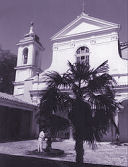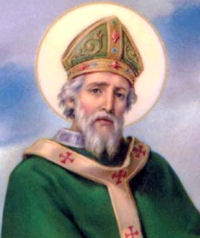Lent: March 17th
Monday of the Second Week of Lent; Opt. Mem. of St. Patrick, Bishop (Solemnity AUS, IRE, Feast NZ, Scotland, Wales)
» Enjoy our Liturgical Seasons series of e-books!
The greatest proof of Christ's charity was given on the Cross. With Christ our gift of ourselves will be given to God as an expression of our love. Communion will lift our human activities up to God's level, not only in will and intention, but in the reality of the sacrament. Let us offer then, and believe, and change our lives into more loving. —St. Andrew Bible Missal
The Church celebrates the Optional Memorial of St. Patrick (b. between 387-390 and died between 461-464) on the General Roman Calendar. However, the liturgical celebration is a Solemnity in Ireland and Australia and a Feast in Scotland, Wales and New Zealand. This day is not all about leprechauns, shamrocks and green beer, but a day to honor and pray to St. Patrick. He was an influential saint who, 1,500 years ago, brought Christianity to the little country of Ireland. He was born about 385 in the British Isles, was carried off while still very young during a raid on Roman Britain by the Irish and sold as a slave. At the end of six years he contrived to escape to Europe, became a monk and was ordained; he then returned to Ireland to preach the Gospel. During the thirty years that his missionary labors continued he covered the Island with churches and monasteries; in 444 he founded the metropolitan see of Armagh. St. Patrick died in 461. After fifteen centuries he remains for all Irishmen the great bishop whom they venerate as their father in the Faith.
Meditation for Monday of the Second Week of Lent—The Value of Fasting
Is fasting really worthwhile? Whenever I consider the value of a religious practice, I always look into the earthly life of our Savior. He is our model. He dwelt with us in order to teach us how to form our lives inwardly and outwardly. Christ Himself fasted often and accorded it high praise in His teaching. Recall how He fasted forty days before entering upon His work of teaching. At the beginning of Lent the Church wishes to stamp this fact deep in our hearts: our fasting must be in union with and in imitation of Christ's.
I call to mind the mystery-laden, pregnant words spoken by our Savior when the disciples, unable to cure a possessed boy, asked, "Why could we not cast him out?," and Jesus answered, "This kind can be driven out in no way except by prayer and fasting" (Mark 9:29). This reply has always made the deepest impression on me. Prayer and fasting are extraordinary means (we may call them violent means) when other simpler ways are of no avail against the powers of hell.
Now another saying of Jesus comes to mind. When John's disciples began to reproach Him, "Why do Your disciples not fast?," He replied: "Can you make the wedding guests fast as long as the bridegroom is with them? As long as they have the bridegroom with them, they cannot fast. But the days will come when the bridegroom will be taken away from them; in those days they will fast" (Luke 5:35). There is a hidden depth of meaning in these words. The coming of Christ among men was a wedding feast. Fasting had no place. But it is most proper too fast when the divine Bridegroom is taken away. Fasting on Fridays and during Holy Week, then, is in accord with Christ's own wishes.
I should like to cite one further passage from the Gospel, one which casts light on fasting from another direction. Once our Savior compared Himself with the Baptist in these words, "John came neither eating nor drinking, and they say, ‘He has a devil!’ The Son of Man came eating and drinking, and they say, ‘Behold a glutton and a wine drinker.’" John was a man devoted to penance, an ascetic, who fasted throughout his life. Not so Christ. His way of living was not based exclusively upon self-denial and mortification, but upon an ordered enjoyment of life. So we learn from the Savior that fasting should be the exception, not the rule, in Christian morality.
To complete the lesson let us consider for a moment the passage in the Sermon on the Mount where Jesus speaks of the three important pious exercises of fasting, prayer, and almsgiving. He highly recommends all three, but warns against practicing these virtues in a pharisaical manner.
The main points in Jesus' doctrine on fasting, then, are:
- Fasting is an extremely important means of resisting the inroads of hell (hence Lent).
- Fasting should be practiced as a memorial of Christ's death (Friday, Holy Week).
- Fast days occur by way of exception in Christian life, they are not the normal practice.
- Fasting holds a place alongside prayer and almsgiving as a pious exercise.
—Excerpted from The Church's Year of Grace, Pius Parsch

Monday of the Second Week of Lent
Station with San Clemente (St. Clement):
The oldest level of St. Clement's is thought to be the titulus Clementis, one of the first parish churches in Rome, and probably belonged to the family of Titus Flavius Clemens, consul and martyr and a contemporary of Pope St. Clement. Set right next to a pagan temple, a Mithraeum or Temple of Mithras, it was one of the first churches in Rome.
For more on San Clemente, see:
- The Station Churches of Rome
- Rome Art Lover
- Roman Churches
- Churches of Rome
- PNAC
- Aleteia
- Station Church
- The Catholic Traveler
For further information on the Station Churches, see The Stational Church.
St. Patrick
Not many facts are known about the life of St. Patrick. We know that he was born around 415 AD, and was a Roman Briton. When he was about 16, while he was tending his sheep some Irish raiders captured him and made him a slave. He eventually was able to escape and return to Britain. There he heard the call to return and bring Christianity to Ireland. He was ordained a priest, consecrated a bishop and came back to Ireland around 435 AD. Many legends are associated around St. Patrick: how he drove the snakes out of Ireland, and the use of the shamrock to teach the mystery of the Trinity. Whether or not the legends are true, St. Patrick succeeded in bringing Catholicism to Ireland, and in time, the whole country converted from their pagan gods to the one true God.
Although a small country, Ireland has played a large role in saving and bringing Christianity throughout the world. During the early Dark Ages, the Irish monasteries preserved Western writings while Europe remained in darkness. But as the Catholic country remained solidly Catholic, the Irish spread the faith to all corners of the world. To learn more on this subject, read Thomas Cahill's How the Irish Saved Civilization.
We have a few works attributed to St. Patrick, one being his autobiography called Confessions. It is a short summary of the events in his life, written in true humility. Below is a short excerpt:
I am greatly God's debtor, because he granted me so much grace, that through me many people would be reborn in God, and soon after confirmed, and that clergy would be ordained everywhere for them, the masses lately come to belief, whom the Lord drew from the ends of the earth, just as he once promised through his prophets: "To you shall the nations come from the ends of the earth, and shall say, Our fathers have inherited naught hut lies, worthless things in which there is no profit." And again: "I have set you to be a light for the Gentiles that you may bring salvation to the uttermost ends of the earth."
Patronage: against fear of snakes; against ophidiophobia; against snake bites; against snakes; barbers; barrel makers; blacksmiths; cattle; coopers; engineers; excluded people; hairdressers; miners; ophidiophobics; Ireland; Nigeria (1961)
See Catholicsaints.info for the long list of different diocese that claim St. Patrick as their patron.
Symbols and Representation: A bishop trampling on snakes; bishop driving snakes away; shamrock; snakes; cross; harp; demons; baptismal font; Purgatory; serpent
Highlights and Things to Do:
- Listen to Catholic Culture's Podcasts and Audiobooks:
- Way of the Fathers by Mike Aquilina, 51—St. Patrick: Paternal and Patristic
- Audiobook read by James Majewski:
- Read more about St. Patrick:
- Honor St. Patrick by trying typical Irish fare: corned beef and cabbage, soda bread, scones, stew, Shepherd's pie, potatoes in various forms and the famous beer and spirits of Ireland. For dessert, try making the Irish Porter Cake. See Catholic Cuisine for some food ideas.
- Read the Lorica (Breastplate) of St. Patrick. Here is an older translation — pray it with your family after your rosary tonight.
- From the Catholic Culture library:
- The Conversion of Ireland by Warren Carroll
- The Irish Soldiers of Mexico by Michael Hogan
- The Irish Madonna of Hungary by Zsolt Aradi
- Our Lady in Old Irish Folklore and Hymns by James F. Cassidy
- Listen to Catholic Culture's Way of the Fathers St. Patrick: Paternal and Patristic by Mike Aquilina.
- St. Patrick's grave is unknown, but his relics are located in Down Cathedral.






